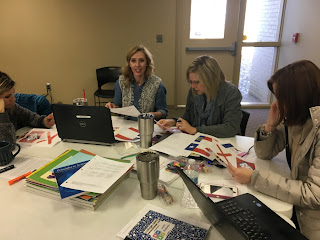Morning Session:
The EMT Cohort participated in a Math Studio Day, where we observed a lesson in Mrs. Bramlett's 5th Grade Classroom. The learning goal for this experience was to recognize and enhance cognitive demand of tasks and lessons, and integrate new knowledge into our own teaching practice.
We followed the Studio Day Protocol developed by the Greater Birmingham Math Partnership.
 1. Setting up the Task - Mrs.Bramlett set the stage for the experience, providing us with the learning goals, background knowledge of students, grouping strategies, and tools students may use.
1. Setting up the Task - Mrs.Bramlett set the stage for the experience, providing us with the learning goals, background knowledge of students, grouping strategies, and tools students may use. 2. Do the Math - Teachers worked the task, anticipating student strategies and misconceptions. We used a Task Analysis Guide to determine the task's cognitive demand, and we explored ways to maintain the level of cognitive demand with students throughout the task.
2. Do the Math - Teachers worked the task, anticipating student strategies and misconceptions. We used a Task Analysis Guide to determine the task's cognitive demand, and we explored ways to maintain the level of cognitive demand with students throughout the task.3. Supporting Students' Exploration of the Task - We discussed how to help students progress through the task and understand key mathematical ideas, using assessing and advancing questions.
4. Discussing the Task - We discussed how Mrs. Bramlett would structure her math congress (the following day).
5. Classroom Observation - We observed in Mrs. Bramlett's classroom for one hour, which included a 15-minute number talk and 45 minutes of the investigative task. We took notes on a graphic organizer for later discussion.
6. Debriefing Session - EMT Teachers participated in a debriefing session to reflect on our observations and what we could take back to improve our teaching practice.
Afternoon Session
We discussed the importance of math practice and application, and explored more engaging alternatives to worksheets. We engaged in these activities as learners!



























































